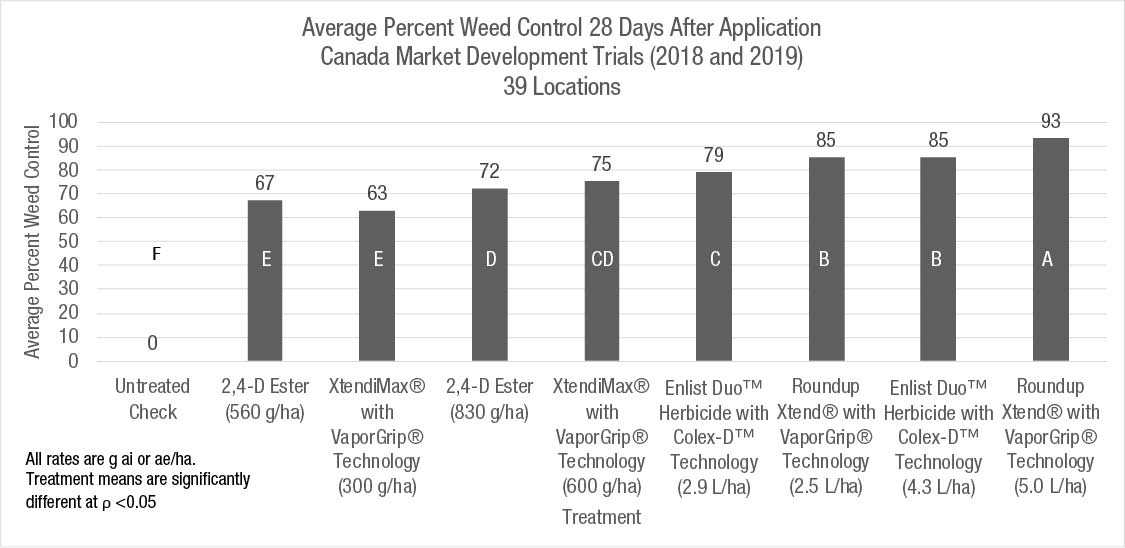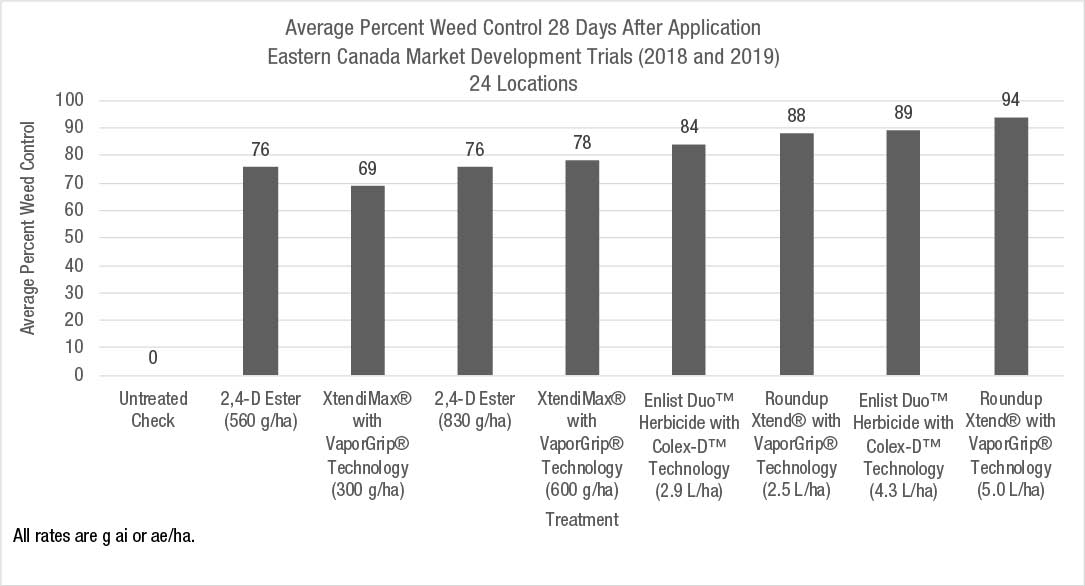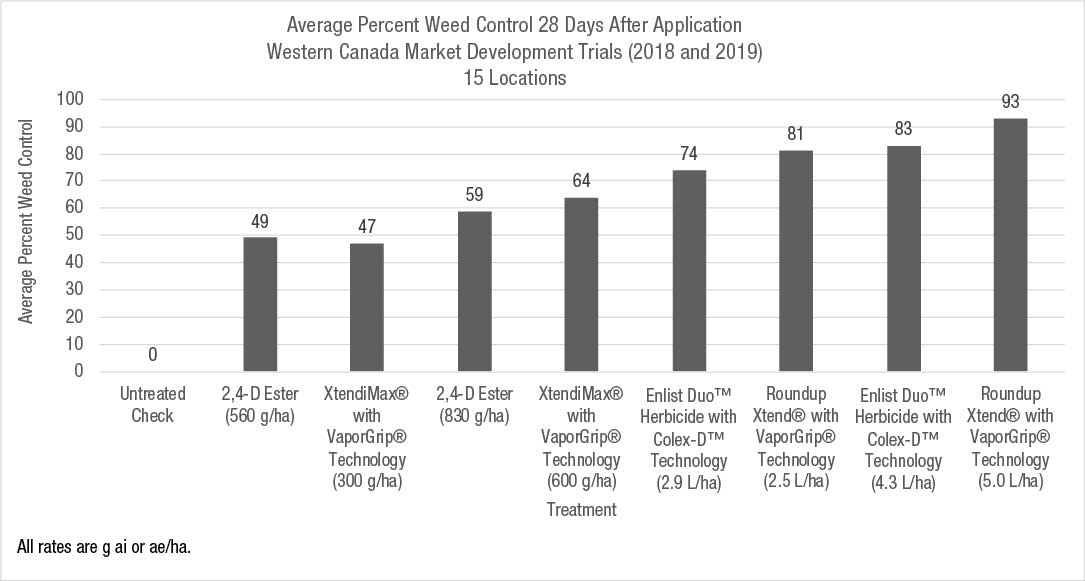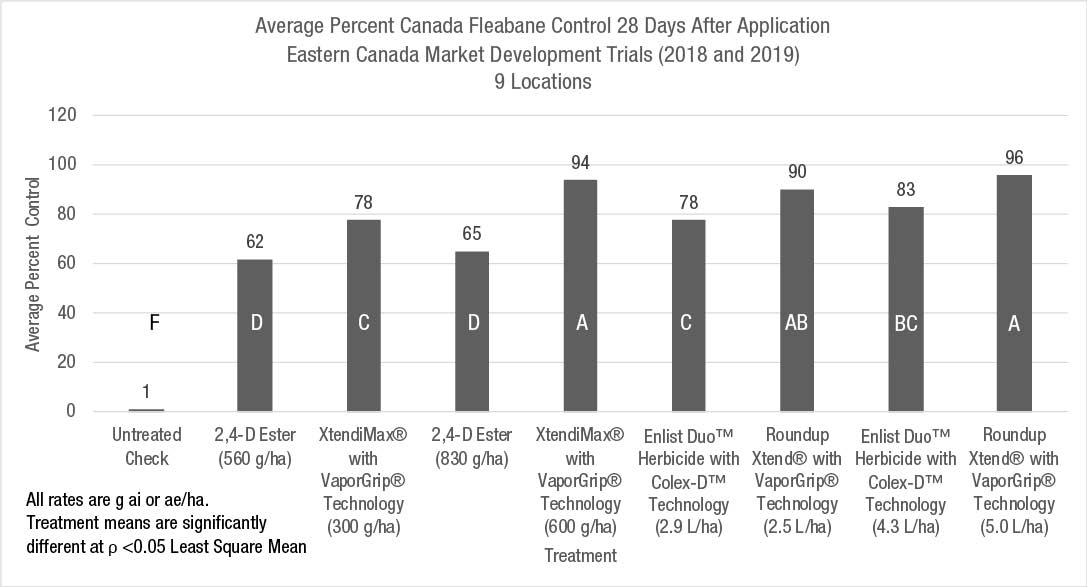Trial Objective
- The objective of the trial was to collect data to compare the benefits and efficacy of the Roundup Ready® Xtend Crop System that includes soybean products with resistance to dicamba to the Enlist™ weed control system that includes soybean products with resistance to 2,4-D choline.
- The Roundup Ready® Xtend Crop System includes the dicamba herbicides Roundup Xtend® with VaporGrip® Technology and XtendiMax® with VaporGrip® Technology.
- The Roundup Ready® Xtend Crop System includes Roundup Ready® 2 Xtend soybeans with resistance to dicamba and glyphosate and XtendFlex® soybeans with resistance to dicamba, glyphosate, and glufosinate.
- Compared to 2,4-D, Bayer testing showed dicamba offered better short-term residual control of small-seeded broadleaf weeds and higher efficacy on some specific annual broadleaf weeds, including the glyphosate resistant weeds kochia (Kochia scoparia) in Western Canada and Canada fleabane (Conyza canadensis) in Eastern Canada. (See Figures for certain rate to rate comparison exceptions).
- Additional objective was to measure the short-term residual control of dicamba versus 2,4-D for small-seeded broadleaf weeds and their efficacy on some specific annual broadleaf weeds, including the glyphosate resistant weeds kochia (Kochia scoparia) in Western Canada and Canada fleabane (Conyza canadensis) in Eastern Canada.
Research Site Details
- This trial was completed over multiple years, 2018 and 2019, and multiple locations:
- 2018: 11 locations in Eastern Canada, 7 locations in Western Canada
- 2019: 13 locations in Eastern Canada, 8 locations in Western Canada
- The trial consisted of nine treatments with three replications in a complete block design.
- Untreated Check
- 2,4-D Ester at 560 g/hectare
- XtendiMax® with VaporGrip® Technology at 300 g/hectare
- 2,4-D Ester at 830 g/hectare
- XtendiMax® with VaporGrip® Technology at 600 g/hectare
- Enlist Duo™ herbicide with Colex-D™ Technology at 2.9 L/hectare
- Roundup Xtend® with VaporGrip® Technology at 2.5 L/hectare
- Enlist Duo™ herbicide with Colex-D™ Technology at 4.3 L/hectare
- Roundup Xtend® with VaporGrip® Technology at 5.0 L/hectare
- Weed control ratings were taken at 14, 21, 28 and 56 days after application (DAA).
- This was a non-crop trial with no crop planted.
Understanding the Results
At 39 trial locations across Canada over 2018 and 2019, the average percent of residual weed control for Roundup Xtend® with VaporGrip® Technology at a rate of 5.0 L/hectare, 28 days after application, was significantly better for general broadleaf weed control (predominate species were lamb’s quarters, red root pigweed, kochia, and Canada fleabane) compared to Enlist Duo™ herbicide with Colex-D™ Technology at a rate of 4.3 L/hectare (Figure 1).
 Figure 1. Average percent weed control 28 DAA at 39 locations across Canada in 2018 and 2019. Total of 110 broadleaf weed hits with the predominate species being lamb’s quarters (23), red root pigweed (18), kochia (9), and Canada fleabane (9).
Figure 1. Average percent weed control 28 DAA at 39 locations across Canada in 2018 and 2019. Total of 110 broadleaf weed hits with the predominate species being lamb’s quarters (23), red root pigweed (18), kochia (9), and Canada fleabane (9).
For this trial, the average percent of residual weed control for Roundup Xtend® with VaporGrip® Technology at a rate of 5.0 L/hectare, 56 days after application, was significantly better for general broadleaf weed control (predominate species were lamb’s quarters, red root pigweed, kochia, and Canada fleabane) compared to Enlist Duo™ herbicide with Colex-D™ Technology at a rate of 4.3 L/hectare (Figure 2).
Additionally, the average percent of residual weed control for Roundup Xtend® with VaporGrip® Technology at a rate of 2.5 L/hectare, 56 days after application, was significantly better for broadleaf weed control (predominate species were lamb’s quarters, red root pigweed, kochia, and Canada fleabane) compared to Enlist Duo™ herbicide with Colex-D™ Technology at a rate of 2.9 L/hectare (Figure 2).
 Figure 2. Average percent weed control 56 DAA at 39 locations across Canada in 2018 and 2019. Total of 110 broadleaf weed hits with the predominate species being lamb’s quarters (23), red root pigweed (18), kochia (9), and Canada fleabane (9).
Figure 2. Average percent weed control 56 DAA at 39 locations across Canada in 2018 and 2019. Total of 110 broadleaf weed hits with the predominate species being lamb’s quarters (23), red root pigweed (18), kochia (9), and Canada fleabane (9).
In Eastern Canada, at 24 trial locations over 2018 and 2019, the average percent of residual weed control for Roundup Xtend® with VaporGrip® Technology at a rate of 5.0 L/hectare, 28 days after application, was 94% for general broadleaf weed control with the predominate species being lamb’s quarters, red root pigweed, and Canada fleabane compared to 89% for Enlist Duo™ herbicide with Colex-D™ Technology at a rate of 4.3 L/hectare, respectively (Figure 3).
 Figure 3. Average percent weed control 28 DAA at 24 locations across Eastern Canada in 2018 and 2019. Total of 73 broadleaf weed hits with the predominate species being lamb’s quarters (16), red root pigweed (10), and Canada fleabane (9).
Figure 3. Average percent weed control 28 DAA at 24 locations across Eastern Canada in 2018 and 2019. Total of 73 broadleaf weed hits with the predominate species being lamb’s quarters (16), red root pigweed (10), and Canada fleabane (9).
Across Western Canada, at 15 trial locations over 2018 and 2019, the average percent of residual weed control for Roundup Xtend® with VaporGrip® Technology at a rate of 5.0 L/hectare was 93% for general broadleaf weed control with the predominate species being lamb’s quarters, red root pigweed, and kochia, 28 days after application, compared to 83% for Enlist Duo™ herbicide with Colex-D™ Technology at a rate of 4.3 L/hectare, respectively (Figure 4).
At the same 15 locations, the average percent of residual weed control for Roundup Xtend® with VaporGrip® Technology at a rate of 2.5 L/hectare was 81% for general broadleaf weed control with the predominate species being lamb’s quarters, red root pigweed, and kochia, 28 days after application, compared to 74% for Enlist Duo™ herbicide with Colex-D™ Technology at a rate of 2.9 L/hectare, respectively (Figure 4).
 Figure 4. Average percent weed control 28 DAA at 15 locations across Western Canada in 2018 and 2019. Total of 37 broadleaf weed hits with the predominate species being lamb’s quarters (7), red root pigweed (8), and kochia (9).
Figure 4. Average percent weed control 28 DAA at 15 locations across Western Canada in 2018 and 2019. Total of 37 broadleaf weed hits with the predominate species being lamb’s quarters (7), red root pigweed (8), and kochia (9).
Across Western Canada, at nine trial locations over 2018 and 2019, the average percent of residual kochia control for the Roundup Xtend® with VaporGrip® Technology treatments, 28 days after application, was significantly better compared to the Enlist Duo™ herbicide with Colex-D™ Technology treatments (Figure 5).
At the same nine locations, the average percent of residual kochia control, 28 days after application, was significantly better for the XtendiMax® with VaporGrip® technology treatments compared to the 2,4-D Ester treatments (Figure 5).
 Figure 5. Average percent kochia control 28 DAA at 9 locations across Western Canada in 2018 and 2019.
Figure 5. Average percent kochia control 28 DAA at 9 locations across Western Canada in 2018 and 2019.
 Figure 6. Residual kochia control comparison, Carseland, Alberta, July 2018.
Figure 6. Residual kochia control comparison, Carseland, Alberta, July 2018.
Across Eastern Canada, at 9 trial locations in 2018 and 2019, the average percent of residual Canada fleabane control for the Roundup Xtend® with VaporGrip® Technology at a rate of 5.0 L/hectare, 28 days after application, was significantly better compared to the Enlist Duo® Herbicide with Colex-D® Technology 4.3 L/hectare treatment (Figure 7).
At the same 9 locations, the average percent of residual Canada fleabane control, 28 days after application, was significantly better for the XtendiMax® with VaporGrip® Technology treatments compared to the 2,4-D Ester treatments (Figure 7).
 Figure 7. Average percent Canada fleabane control 28 DAA at nine locations across Eastern Canada in 2018 and 2019.
Figure 7. Average percent Canada fleabane control 28 DAA at nine locations across Eastern Canada in 2018 and 2019.
 Figure 8. Canada fleabane control comparison, Thamesville, Ontario, 2019.
Figure 8. Canada fleabane control comparison, Thamesville, Ontario, 2019.
Key Learnings
- The trial results demonstrated overall broadleaf weed control and short-term residual weed control benefits of dicamba compared to 2,4-D Ester.
- For this trial, the broadleaf weed control of Roundup Xtend® with VaporGrip® Technology was significantly better than the broadleaf weed control of Enlist Duo™ with Colex-D™ Technology.
- A Roundup brand tank-mix partner should always be included with XtendiMax® herbicide with VaporGrip® Technology. Applying dicamba alone in the Roundup Ready® Xtend Crop System is not recommended.
- Roundup Xtend® with VaporGrip® Technology and XtendiMax® with VaporGrip® Technology provided control of glyphosate resistant Canada fleabane and glyphosate resistant kochia.
Legal Statements
The information discussed in this report is from a multiple site, replicated demonstration. This informational piece is designed to report the results of this demonstration and is not intended to infer any confirmed trends. Please use this information accordingly.
Bayer is a member of Excellence Through Stewardship® (ETS). Bayer products are commercialized in accordance with ETS Product Launch Stewardship Guidance, and in compliance with Bayer’s Policy for Commercialization of Biotechnology-Derived Plant Products in Commodity Crops. These products have been approved for import into key export markets with functioning regulatory systems. Any crop or material produced from these products can only be exported to, or used, processed or sold in countries where all necessary regulatory approvals have been granted. It is a violation of national and international law to move material containing biotech traits across boundaries into nations where import is not permitted. Growers should talk to their grain handler or product purchaser to confirm their buying position for these products. Excellence Through Stewardship® is a registered trademark of Excellence Through Stewardship.
ALWAYS READ AND FOLLOW PESTICIDE LABEL DIRECTIONS. Performance may vary from location to location and from year to year, as local growing, soil and weather conditions may vary. Growers should evaluate data from multiple locations and years whenever possible and should consider the impacts of these conditions on the grower’s fields.
It is a violation of federal law to use any pesticide product other than in accordance with its labeling. NOT ALL formulations of dicamba or glyphosate are approved for in-crop use with products with Roundup Ready 2 Xtend® soybeans. NOT ALL formulations of dicamba, glyphosate or glufosinate are approved for in-crop use with products with XtendFlex® Technology. ONLY USE FORMULATIONS THAT ARE SPECIFICALLY LABELED AND APPROVED FOR SUCH USES. Contact the Pest Management Regulatory Agency with any questions about the approval status of dicamba herbicide products for in-crop use with Roundup Ready 2 Xtend® soybeans or products with XtendFlex® Technology.
Products with XtendFlex® Technology contains genes that confer tolerance to glyphosate, glufosinate and dicamba. Roundup Ready 2 Xtend® soybeans contains genes that confer tolerance to glyphosate and dicamba. Glyphosate will kill crops that are not tolerant to glyphosate. Dicamba will kill crops that are not tolerant to dicamba. Glufosinate will kill crops that are not tolerant to glufosinate. Contact your Bayer retailer, refer to the Bayer Technology Use Guide, or call the technical support line at 1-800-667-4944 for recommended Roundup Ready® Xtend Crop System weed control programs.
Tank mixtures: The applicable labeling for each product must be in the possession of the user at the time of application. Follow applicable use instructions, including application rates, precautions and restrictions of each product used in the tank mixture. Bayer has not tested all tank mix product formulations for compatibility or performance other than specifically listed by brand name. Always predetermine the compatibility of tank mixtures by mixing small proportional quantities in advance. Bayer, Bayer Cross, Roundup Ready 2 Xtend® , Roundup Ready 2 Yield® , Roundup Ready® , Roundup Xtend® , VaporGrip® , XtendFlex® and XtendiMax® are registered trademarks of Bayer Group. Used under license. LibertyLink™ and the Water Droplet Design are trademarks of BASF. Used under license. All other trademarks are the property of their respective owners. Bayer CropScience Inc. is a member of CropLife Canada. ©2021 Bayer Group. All rights reserved. 1020_R3

